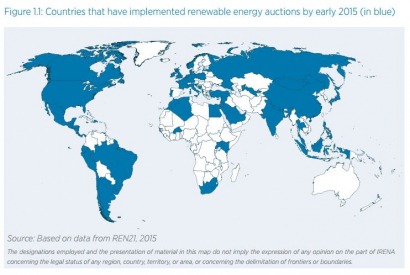
The six-volume guidebook Renewable Energy Auctions: a Guide to Design, finds that more than 60 countries have now adopted renewable energy auctions, up from six in 2005, largely due to their ability to attract competition and drive down costs.
“In an era of rapidly declining costs and growing deployment in renewable energy, policies are being adapted to maintain efficiency and effectiveness,” said IRENA Director-General Adnan Z. Amin. “In this context, one of the most significant recent policy developments is the growing popularity of renewable energy auctions.”
The guide analyses auction design elements and highlights best practices for policy makers and investors considering auctions in their own countries. It finds that auctions around the world attract investment and decrease costs through competition.
In South Africa for example, a commitment to multiple bidding rounds increased the number of bids by nearly 50 percent and decreased the cost of photovoltaic and wind by 39 and 23 per cent respectively. Similarly in the United Arab Emirates, an auction in Dubai this year contracted for the lowest-ever price of electricity from a solar park, without financial support, at less than US 6 cents per kilowatt-hour.
The new guidebook includes a summary for policy makers and an overview of renewable energy policies and auctions. It also includes technical auction design sections on demand, qualification requirements, the winner selection process and sellers’ liabilities.
It builds on IRENA’s 2013 report Renewable Energy Auctions in Developing Countries, which demonstrated the effectiveness of auctions in selected markets, including Brazil, China, Morocco, Peru and South Africa.
For additional information:

